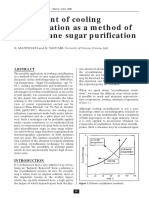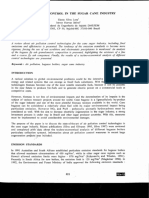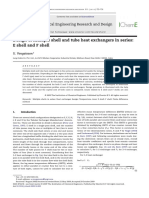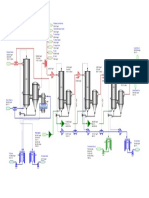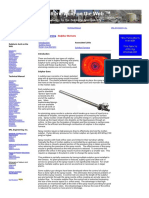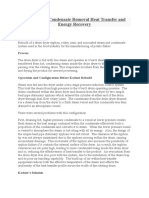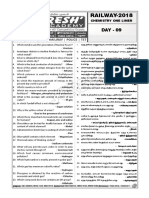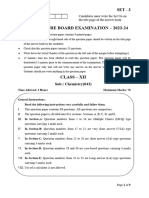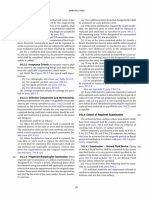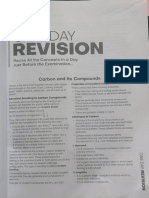Jigger Tube - IsSCT Technical Paper
Jigger Tube - IsSCT Technical Paper
Uploaded by
maithanhhaiCopyright:
Available Formats
Jigger Tube - IsSCT Technical Paper
Jigger Tube - IsSCT Technical Paper
Uploaded by
maithanhhaiCopyright
Available Formats
Share this document
Did you find this document useful?
Is this content inappropriate?
Copyright:
Available Formats
Jigger Tube - IsSCT Technical Paper
Jigger Tube - IsSCT Technical Paper
Uploaded by
maithanhhaiCopyright:
Available Formats
FP24 A NEW DESIGN OF JIGGER SYSTEM TO IMPROVE VACUUM PAN PERFORMANCE
By D.W. RACKEMANN and R. BROADFOOT Sugar Research and Innovations @ QUT, Brisbane, Australia d.rackemann@qut.edu.au KEYWORDS: vacuum pan, steam jigger, circulation, heat transfer. Abstract A new jigger system has been designed by SRI to boost circulation and heat transfer rates in vacuum pans. The jigger system injects and distributes numerous small bubbles of steam/incondensible gases at controllable rates into the base of the pan. Circulation is improved through a combination of the rising bubbles and the increased heat transfer that results from the increased velocity of massecuite through the tubes. The jigger system offers benefits to the pans performance throughout the entire pan cycle. Trials were undertaken during the 2004 and 2005 seasons on batch and continuous pans in Australia to determine the performance during operation with and without the jigger system. The performance was assessed by taking circulation measurements using anemometer probes, measuring heat transfer from the calandria section of the pan, monitoring the calandria pressure and steam flow rate during operation and monitoring the production rate of massecuite. The installation of the jigger system shows substantial performance improvements including: Reduced calandria pressure; Improved heat transfer coefficients; Increased circulation velocities; Shorter batch pan cycle times; and Production of massecuites at higher brix. Additional advantages of the jigger system include: Relatively cheap and low maintenance; Reduced need for balance water and the use of surfactants; and The pipework system does not block with massecuite so nonreturn valves are not required. The jigger system can be retrofitted to existing batch and continuous pans of any design.
Page 1 of 10
Introduction Strong circulation movement of the massecuite in vacuum pans is required to provide adequate mixing of the contents in the pan and create uniform conditions for crystallisation. As well, a strong circulation flow enhances the heat transfer from the condensing steam in the calandria to the massecuite. Circulation occurs due to the buoyancy forces provided by the vapour bubbles released from the massecuite inside, and above, the tubes. The movement of the massecuite resulting from ebullition is known as natural circulation and is illustrated in figure 1. A strong circulation flow allows the pan to be controlled at a higher (but safe) supersaturation level and provides benefits in productivity, product sugar quality, and efficiency.
Fig 1 - Circulation patterns in a batch vacuum pan For cane sugar factories that wish to reduce the process steam consumption, e.g. for increased co-generation, supply of steam or bagasse to other users, low pressure vapour from the juice evaporator station will likely be used for boiling the vacuum pans, instead of using process steam. The use of low pressure vapour on the pans reduces the maximum temperature differential for heat transfer (between the vapour and the boiling massecuite in the pans) and this will impact negatively on the maximum heat transfer rate and circulation movement that may be achieved by natural circulation. Depending on the design of the pan and the production duty, the smaller temperature differential may detract from the productivity (increasing the time to complete the crystallisation cycles), the yield of sugar crystals and the quality of the crystals produced.
Page 2 of 10
Jigger system Modifications can be made to the ancillary equipment and operations of pans (Miller, 2001) to enhance the circulation movement and heat transfer in order to negate the effects of operating with a reduced temperature differential. The use of jigger steam is one option. This project examined and developed a cost-effective method using jiggers to allow vacuum pans to operate more successfully on low pressure vapours. The incondensible gases from the calandria space are injected into the base of the pan through a finely distributed system to boost the circulation movement. While jigger systems using incondensible gases have been used in the sugar industry with varying levels of success (Stobie, 1998; Vermeulen and Pillay, 2000; Moor, 2002), the novelty of the SRI design is in the multitude and fine size of the perforations (or release holes) in the jigger system. The perforations govern the size of the vapour or gas bubbles released in the vacuum pan. The very small size of the holes has been shown to prevent back flow of material into the system. The jigger system, for batch pans comprises a multiple-sided jigger ring installed and fixed to the bottom of the pan. The tubes are stainless steel and have numerous laser cut holes facing upwards. A one metre length of laser cut jigger tube has approximately 100,000 holes of ~0.2 mm diameter. The jigger tubes are cut and welded to make the multi-sided ring. Figure 2 shows the arrangement of the jigger system for a typical batch fixed calandria pan. Incondensible gases that are removed from the calandria space and normally vented to the headspace of the pan are directed to the jigger system in the base of the pan. Some vapour will be drawn from the calandria with the incondensible gases but this quantity is very small relative to the total steam supply to the calandria. An attractive feature of the system is that the incondensible gases are a waste stream and the benefit to circulation is basically achieved without sourcing an additional energy supply, e.g. extra steam or mechanical stirrer. The important aspects of the jigger design are to ensure (i) the injected gas/vapour is uniformly distributed around the circumference at the base of the pan, (ii) the released bubbles are numerous and small in diameter to provide maximum benefit to the increase in buoyancy, and (iii) the system is not prone to blocking with massecuite when the head space is vented to atmosphere and the full head of massecuite in the pan is exerted on the holes in the jigger system. Figure 2 shows the simple control system required for operation of the jigger system for a typical batch pan installation. The jigger system can be controlled by a manual globe/gate valve to provide a pressure differential of 10 to 20 kPa (between the noxious gas inlet and the pressure within the massecuite at the base of the pan) during operation. This should provide an adequate flow of noxious gas/vapour. Simple manual setting is adequate as once set, no adjustment is needed.
Page 3 of 10
TO CONDENSER / ATMOSPHERE NOXIOUS GAS / VAPOUR LINE BOILING LEVEL MANUAL VALVE FOR CONTROL
CALANDRIA
JIGGER RING INLET
SOCKET FOR PRESSURE MEASUREMENT
PT
Fig 2 Arrangement for installation of the jigger system Methodology The research was undertaken in several phases as described below: (a) Laboratory tests were undertaken with perforated sheets to determine the preferred hole size and differential pressure. (b) The performance of a number of batch and continuous pans were assessed while operating under current process steam and simulated low pressure vapour conditions. (c) The SRI jigger system was retrofitted into the batch and continuous pans and the performance of the modified pans evaluated with the jigger system in operation. (d) Based on the results, refinements were incorporated into the jigger system design. Factory trials Trials were carried out during the 2003, 2004 and 2005 seasons at a number of Australian mills on batch and continuous pans. These trials were conducted both with and without the jigger system installed and operating. Heat transfer data and circulation measurements were collected during these trials. Hot film anemometers were used to provide quantitative and qualitative information on circulation velocities within the vacuum pan at a number of locations (Rackemann and Stephens, 2002). Other pan operating parameters such as the pan level, steam flow rate, operating pressure in the head space (vacuum), calandria pressure, massecuite conductivity, feed control valve position and balance water control valve position were logged during the factory trials. Measurements
Page 4 of 10
were obtained for multiple pan cycles and the average pan cycle times and production rates were recorded for the trials. Batch pan results Circulation Circulation velocities vary with changes in the operating conditions in the pan. Figure 3 shows an example for a 200 t batch A massecuite pan where circulation velocities were measured for two pan cycles. One cycle (run A) was operated with the jigger system turned off. For both cycles the anemometer probe was positioned underneath and approximately midway across the width of the calandria and 250 mm from the pan floor. Figure 3 shows that during the majority of the pan cycle the jigger improved the circulation rates. However at the end of the pan cycle (>180 t) the trend is reversed. The lower circulation velocities with the jigger system in operation are attributed to the heavier massecuite boiled during the heavy up phase with the use of the jigger system. This is evident from the higher resistance (measured by a massecuite conductivity probe) shown in Figure 3 for this run. The example illustrates the need for care in comparing pan cycles to determine the improvements in performance obtained with operating the jigger system.
0.5
65
Heavy up period
0.4 60
Circulation velocity, m/s
0.2
50
0.1
Run Run Run Run
1 - Velocity (Jigger on) A - Velocity (Jigger off) 1 - Resistance (Jigger on) A - Resistance (Jigger off)
45
0 90 120 150 180
40 210
Operating quantity in pan, t
Fig 3 - Measured circulation velocities and resistance values against operating pan level for a 200 t pan showing the effects of the jigger system While the results among the different tests are confounded by changes in operating conditions and massecuite properties, circulation velocities are generally increased through the use of the jigger system. The largest benefits were measured in the outer region of the pan underneath the calandria and near the end of the pan cycle. The factory data shows that the jigger system provides a greater increase in motive power in the pan towards the end of the
Page 5 of 10
Resistance
0.3
55
pan cycle, in much the same way as stirrers provide maximum benefit during the heavy up phase. The jigger system improved the circulation velocities in the batch pans by up to 1520%. As well, for comparing data with the jigger on or off, there is a possibility that the jigger pipes themselves (with steam off) may restrict the flow path sufficiently to slow the circulation velocity especially when the level in the pan is low. In some pan installations the jigger was installed as a half pipe that was attached to the base of the pan, so this influence was minimised. Heat transfer Heat transfer rates are calculated from the steam rate condensed in the calandria. The overall apparent heat transfer coefficient is defined (Austmeyer, 1986) as,
U =
Q A Teff
(1)
Where U is the overall heat transfer coefficient, W/m2/K; Q is the heat flux, W; A is the area available for heat transfer, m2; and Teff is the effective temperature difference, K. The effective temperature difference is defined as the difference in temperature between the condensing steam in the calandria and the boiling temperature of the massecuite in the pan. The boiling temperature is estimated from the saturated vapour temperature at the operating pressure in the head space plus the boiling point elevation calculated for the average massecuite conditions in the pan using the method described by Batterham and Norgate (1975). Figure 4 shows the calculated heat transfer coefficients for a 200 t batch A massecuite pan for several pan cycles where the steam rate applied to the pan was initially set at 25 t/h. There is a consistent gradual decrease in the heat transfer coefficient throughout the pan cycles as the operating level (massecuite quantity) increases. This decrease reflects the reduction in heat transfer, which can be directly linked to reduced circulation that occurs as the boiling level above the calandria increases and the viscosity of the circulating material increases. A very large decrease in the heat transfer coefficient occurs during the heavy up period, and this is common in all batch vacuum pans. During the heavy up period the feed to the pan is shut off and the crystal content is increased as much as possible to maximize the crystal yield. During this period (which is at pan full for a batch pan) the viscosity of the massecuite increases and is at its maximum at pan drop. The results in Figure 4 show the heat transfer coefficient was significantly improved with the jigger system in operation, especially towards the end of the pan cycle.
Page 6 of 10
500
Heat transfer coefficient, W/m2/K
Heavy up period
400
300
200
Run A (Jigger off)
100
Run B (Jigger off) Run 1 (Jigger on) Run 2 (Jigger on)
0 90 120 150 180 210
Operating quantity in pan, t
Fig 4 - Comparison of heat transfer coefficient against operating quantity in the pan for factory trials on a 200 t A massecuite pan with similar steam rates showing the effect of the jigger system Based on the results of several tests on the 200 t A massecuite pan it was found that the jigger system generally improved the heat transfer coefficient by 5% at the start of the pan cycle and up to 30% during the heavy up period. The magnitude of improvement produced by the jigger system will depend on how well the batch pan normally performs. It is expected that poorly designed and larger pans will benefit most from the operation of the jigger system. Other performance criteria In the operation of a batch pan, when the calandria pressure reaches the pressure of the steam supply, the steam flow will start to reduce as the boiling becomes limited by the heat transfer from the steam to the massecuite in the calandria. This reduction in heat transfer can be caused by changes in the properties of the massecuite (i.e. increase in crystal content and viscosity), depression of ebullition due to the high level of massecuite above the calandria and by fouling of the calandria tubes. In all cases slower circulation rates would be present in natural circulation pans. Figure 5 shows the steam rate and measured calandria pressure for selected monitored pan cycles (in the same 200 t pan) where the set point for the steam rate to the pan was similar. In Figure 5, the effect of the increased circulation created by the jigger system reduces the calandria pressure by 15 to 30 kPa throughout the majority of the pan cycle. The reduction in calandria pressure allows the steam rate to be maintained at the set point value for longer before the decline at the end of the pan cycle. The ability of the pan to maintain higher steam rates with the jigger system in operation also leads to a small reduction in pan cycle times of around 2 - 4%.
Page 7 of 10
120 25
100 20 80 15
Heavy up period
10
60
40
Run A (Jigger off) steam rate
5
Run 1 (Jigger on) steam rate Run A (Jigger off) calandria pressure Run 1 (Jigger on) calandria pressure
20
0 90 110 130 150 170 190
0 210
Operating quantity in pan, t
Fig 5 - Comparison of calandria pressure and steam rate against operating pan level for selected factory trials on a 200 t pan with similar steam rates showing the effect of the jigger system Jigger systems were installed in other batch pans and allowed one mill to replace their existing high pressure steam jiggers without any reduction in performance. As well the pan no longer used a magma pan aid (surfactant) during the boiling of magma charges. The jigger system also eliminated the previous problems of the high pressure jigger pipes blocking with molasses and massecuite due to backflow when the jigger steam was not applied. Continuous pan results Jigger pipes were also installed in continuous pans producing both A and C massecuites. The installation of a jigger pipe section into a continuous C massecuite pan is shown in Figure 6.
Page 8 of 10
Calandria pressure, kPa
Steam flow rate, t/h
Bottom of calandria tube plate
SRI jigger pipe
Previous HP steam jigger system
Fig 6 - Jigger pipe installed under the calandria in a continuous C pan While anemometer probes were not always used to measure and quantify the circulation, visual observation of the boiling surface showed that the jigger system provided a noticeable improvement in circulation within the pan. The jigger system also enabled the dry substance of the product C massecuite to be consistently held 0.4 to 0.5 units higher than when the high pressure steam jiggers were being used, allowing greater exhaustion to be achieved. As well, the calandria pressure of the final calandria module of the continuous pan reduced by 3 to 8 kPa relative to no jiggers being used. The calandria pressure in continuous pans builds up over time to the steam supply pressure when the steam rate then declines. With the operation of the jigger system the rate of increase of the calandria pressure was slightly reduced, thus slightly increasing the operating time between cleans. Conclusions The jigger system designed by SRI consists of a pipe system with fine perforations (size ~0.2 mm diameter) to distribute a multitude of very fine gas bubbles into the base of vacuum pans to assist circulation. The drag provided by the rising (and expanding) gas bubbles as they pass through the massecuite generates an increase in circulation velocity of the massecuite and also helps to increase the heat transfer. As a consequence the calandria pressure is reduced for a given rate of steam. Performance evaluation trials were conducted on batch and continuous pans. All installations demonstrated the benefits of increased circulation velocity, increased heat transfer coefficient and reduced calandria pressure. The results indicated that the jigger system will allow pans to maintain higher evaporation (vapour) rates for given operating conditions compared to operation of the pans without the jigger system. Increased productivity was demonstrated through slightly shorter batch cycle times and increased crystal yield.
Page 9 of 10
The new SRI jigger system is suitable to be retrofitted to any batch or continuous pan. Mill tradesmen can cut and weld the supplied tubes to suit the particular pan. Thus the installation is relatively cheap. The most favoured applications are for: (1) pans that demonstrate poor circulation; (2) key pans on the pan stage where an increase in production rate will increase the productivity of the whole pan stage; and (3) pans that are required to process massecuites at greater than their design rate. An attractive feature of the new SRI jigger system is that the holes are sufficiently small to almost totally eliminate the flow back of molasses (or massecuite) into the pipe work. This eliminates the need for non-return valves and problems with blockage of pipe work and valving.
Acknowledgement SRI acknowledges the financial contribution by the Queensland Government, through the Queensland Sustainable Energy Innovation Fund. Other funds were provided by SRI. The assistance provided by several Australian mills to install and trial prototype SRI jigger systems is appreciated.
REFERENCES Austmeyer, K.E. (1986). Analysis of sugar boiling and its technical consequences Part II. Heat transfer during sugar boiling. Int. Sugar Jnl., 88: 23-29. Batterham, R.J. and Norgate, T.E. (1975). Boiling point elevation and superheat in impure cane sugar solutions. Int. Sugar Jnl., 77: 359-364. Miller, K.F. (2001). Productivity improvement in batch pans. Proc. Aust. Soc. Sugar Cane Technol., 23: 346-350. Moor, B. (2002). Energy aspects of assisted pan circulation. ISSCT Engineering Workshop Energy management in raw cane sugar factories, Berlin. Rackemann, D.W. and Stephens, D.W. (2002). Determining circulation velocities in vacuum pans. Proc. Aust. Soc. Sugar Cane Technol., 24: 452-458. Stobie, R.M. (1998). Pneumatic agitation of high grade massecuite in a 136 m3 batch pan. Proc. Aust. Soc. Sugar Cane Technol., 20: 362-365. Tait, P.J., Greig, C.R. and Abernethy, P.E. (1995). High grade continuous pans: to stir or not to stir. Proc. Aust. Soc. Sugar Cane Technol., 17: 244-249. Vermeulen, P.L.M. and Pillay, V. (2000). Preliminary evaluation of modifications to the FCB continuous evaporating crystallizers at Eston and Sezela. Zuckerindustrie, 125: 793-798.
Page 10 of 10
You might also like
- PINDSTRUP SUBSTRATES Descriptor Seeding & Plus OrangeDocument2 pagesPINDSTRUP SUBSTRATES Descriptor Seeding & Plus OrangeJuan MejiasNo ratings yet
- Api 54Document1 pageApi 54keyur1109No ratings yet
- Helmholtz Energy Equation of StateDocument10 pagesHelmholtz Energy Equation of StateSantiago MolinaNo ratings yet
- Heat Exchanger Specification Sheet US Units: 47,5 InchDocument1 pageHeat Exchanger Specification Sheet US Units: 47,5 InchGreisly MarrugoNo ratings yet
- KN Series Control Manual (KNCT2-1011)Document88 pagesKN Series Control Manual (KNCT2-1011)Sunil PawarNo ratings yet
- Importance of Recirculation in Evaporators: Chemical Engineer, American Crystal Sugar CompanyDocument2 pagesImportance of Recirculation in Evaporators: Chemical Engineer, American Crystal Sugar CompanyJavier Manuel IbanezNo ratings yet
- Cristalizacion EnfriamientoDocument9 pagesCristalizacion EnfriamientoHector Joel Chaname RodriguezNo ratings yet
- English Unit Spec SheetDocument3 pagesEnglish Unit Spec SheetDanang PrakosaNo ratings yet
- Boiling Point Elevation of Sucrose Solutions.109125520Document12 pagesBoiling Point Elevation of Sucrose Solutions.109125520Mahesh SalotagiNo ratings yet
- Sahadeo 2002 - ClarificationDocument12 pagesSahadeo 2002 - ClarificationKhaliq HussainNo ratings yet
- Modifications To and Experiences With R, Apidorr Clarifiers Including Saccharate Liming at AmatikuluDocument4 pagesModifications To and Experiences With R, Apidorr Clarifiers Including Saccharate Liming at AmatikuluJavier Manuel IbanezNo ratings yet
- Heat Exchanger Design - Part 2Document15 pagesHeat Exchanger Design - Part 2Siddhant SoymonNo ratings yet
- SRI Jigger Steam ManualDocument23 pagesSRI Jigger Steam ManualzalabiNo ratings yet
- Cane PreparationDocument2 pagesCane PreparationOmar Ahmed ElkhalilNo ratings yet
- 1974 Murray Filtering Quallity of RAw Sugar - Mechanism of Starch Influence in CarbonatationDocument11 pages1974 Murray Filtering Quallity of RAw Sugar - Mechanism of Starch Influence in CarbonatationnghiNo ratings yet
- Evaporation Principles and Black Liquor Properties: David T. Clay, PH.DDocument6 pagesEvaporation Principles and Black Liquor Properties: David T. Clay, PH.DJKKNo ratings yet
- Falling Film Evaporator Application, Adv and Dis AdvDocument8 pagesFalling Film Evaporator Application, Adv and Dis Advkishna009No ratings yet
- Mill Performance Monitoring at Gledhow Sugar MillDocument3 pagesMill Performance Monitoring at Gledhow Sugar Millmazumah5437No ratings yet
- Shell Data:: Input Echo, Tubesheet Number 1, Description: Main ShellDocument8 pagesShell Data:: Input Echo, Tubesheet Number 1, Description: Main ShellAbhishek LadNo ratings yet
- Description Materials: Cast Iron For Horizontal InstallationDocument2 pagesDescription Materials: Cast Iron For Horizontal InstallationParth GosaiNo ratings yet
- M.tech. Sugar TechnologyDocument25 pagesM.tech. Sugar TechnologyrrameshsmitNo ratings yet
- Air Ejector Cheaper Than SteamDocument5 pagesAir Ejector Cheaper Than Steamjungmuk100% (1)
- Cane Factory MillingDocument5 pagesCane Factory MillingzalabiNo ratings yet
- Air Pollution Control in The Sugar Cane PDFDocument10 pagesAir Pollution Control in The Sugar Cane PDFMiguel Angel Rozo ArangoNo ratings yet
- Condenser 69-83Document15 pagesCondenser 69-83DIPAK VINAYAK SHIRBHATENo ratings yet
- Control Philosophy Continuous Pan Jay Shree Sugar MillDocument12 pagesControl Philosophy Continuous Pan Jay Shree Sugar MillSachinNo ratings yet
- WWW Sugarprocesstech Com Condenser SystemDocument20 pagesWWW Sugarprocesstech Com Condenser SystemRuju RidhaniNo ratings yet
- Data Mesin Audit 2015Document34 pagesData Mesin Audit 2015damanik99No ratings yet
- Steam and Condensate SystemDocument5 pagesSteam and Condensate SystemAayush AgrawalNo ratings yet
- Density of Milk Lime SolutionDocument2 pagesDensity of Milk Lime SolutionLuis Miguel La Torre100% (1)
- An Engineering Approach To Design A Non Centrifugal Cane S 2020 Journal of FDocument12 pagesAn Engineering Approach To Design A Non Centrifugal Cane S 2020 Journal of Fluis ulloaNo ratings yet
- Review On Design and Operation of Clarifiers in The South African Sugar Industry For The Period 1975 To 1995Document3 pagesReview On Design and Operation of Clarifiers in The South African Sugar Industry For The Period 1975 To 1995Jomhel CalluengNo ratings yet
- EMDGDocument112 pagesEMDGbasantsri100% (1)
- Neral Yoensa PDFDocument102 pagesNeral Yoensa PDFWalter Sandoval100% (1)
- Design of Multiple Shell and Tube Heat Exchangers in Series E Shell and F ShellDocument12 pagesDesign of Multiple Shell and Tube Heat Exchangers in Series E Shell and F ShellLiu YangtzeNo ratings yet
- By P.G. Wright, A.C. Fernandes and Florenal ZarpelonDocument13 pagesBy P.G. Wright, A.C. Fernandes and Florenal ZarpelonCarlos TomeyNo ratings yet
- Air Cooled Heat Exchanger Preliminary SelectionDocument4 pagesAir Cooled Heat Exchanger Preliminary SelectionAA GGNo ratings yet
- Impeller PerformanceAug17 FRDocument10 pagesImpeller PerformanceAug17 FRSteve WanNo ratings yet
- Anexo Ii Gea BischoffDocument16 pagesAnexo Ii Gea BischoffFelipe Andres Jaque DelgadoNo ratings yet
- Molasses Conditioning: Additional Heating SurfaceDocument1 pageMolasses Conditioning: Additional Heating SurfaceTung Bui ThanhNo ratings yet
- Design and Development of Sand Bed FilterDocument22 pagesDesign and Development of Sand Bed FilterAncuta TrifoiNo ratings yet
- Steam Condensation ReportDocument17 pagesSteam Condensation ReportKingsley EdemidiongNo ratings yet
- Sugar Research & Innovation, Queensland University of Technology, AustraliaDocument10 pagesSugar Research & Innovation, Queensland University of Technology, AustraliaTeena AlawadNo ratings yet
- Eta SeriesDocument16 pagesEta SeriesjoejumbooNo ratings yet
- Coussin FirestoneDocument2 pagesCoussin FirestoneReaderRider100% (1)
- FT&HXDocument55 pagesFT&HXKelvin TanNo ratings yet
- API 614 Comments Mac-Su-3563-EDocument17 pagesAPI 614 Comments Mac-Su-3563-EJESUSNo ratings yet
- Fuel Ethanol Distillation - Fundamentals - KatzenDocument18 pagesFuel Ethanol Distillation - Fundamentals - Katzenaseptman1100% (1)
- Drum Dryer Moisture ControlDocument12 pagesDrum Dryer Moisture ControlJason RichardsonNo ratings yet
- BurnersDocument2 pagesBurnersArfianti Kurnia Nur FadillaNo ratings yet
- SRI Jigger Tubes System Delivers Improved Vacuum Pan PerformanceDocument2 pagesSRI Jigger Tubes System Delivers Improved Vacuum Pan PerformanceRoberto Rasgado Marroquin100% (1)
- ME LAB MANUAL RevisedDocument64 pagesME LAB MANUAL RevisedClint Baring ArranchadoNo ratings yet
- Control PH para Evitar Perdas EvapDocument12 pagesControl PH para Evitar Perdas EvapjavierNo ratings yet
- 1994 Gibbon Cad Thrashplate DesignDocument3 pages1994 Gibbon Cad Thrashplate DesignsurachsNo ratings yet
- Sugar - Fluid Flow VelocitiesDocument4 pagesSugar - Fluid Flow VelocitiesOmar Ahmed ElkhalilNo ratings yet
- 06 P F PlantDocument161 pages06 P F Planthirenkumar patelNo ratings yet
- 13-Sanaullah, Steam Jigging System, PSST 2015Document14 pages13-Sanaullah, Steam Jigging System, PSST 2015nghiNo ratings yet
- 499 To 511 M 09 Broadfoot and McFeatersDocument14 pages499 To 511 M 09 Broadfoot and McFeatersmarcio_limaNo ratings yet
- A Venturi Scrubber Used To Clean Gasifier Syngas Results in PDFDocument5 pagesA Venturi Scrubber Used To Clean Gasifier Syngas Results in PDFPaoLa MonTañoNo ratings yet
- JT LTS Vs VortexDocument4 pagesJT LTS Vs VortexIlya Popik100% (1)
- Drum Dryer Heat Transfer Heat RecoveryDocument3 pagesDrum Dryer Heat Transfer Heat RecoveryRajendra GuptaNo ratings yet
- Fred Redmore - ChemistryDocument12 pagesFred Redmore - ChemistryMark Anthony SantosNo ratings yet
- 2017 - 06 - Armaflex FRV PDFDocument8 pages2017 - 06 - Armaflex FRV PDFNaqqash SajidNo ratings yet
- Concreto Collection 2 0 2 0Document13 pagesConcreto Collection 2 0 2 0Akash AnandNo ratings yet
- Carbozinc 11: Selection & Specification DataDocument5 pagesCarbozinc 11: Selection & Specification DataQuy RomNo ratings yet
- Maintenance: Ca PKX 27 / Ca SLDDocument16 pagesMaintenance: Ca PKX 27 / Ca SLDCoil98100% (1)
- RAILWAY-2018: Chemistry One LinerDocument2 pagesRAILWAY-2018: Chemistry One LinerVijayNo ratings yet
- SteelDocument22 pagesSteels63et79jgeesdgNo ratings yet
- Chapter 2 Review Worksheet-GeneralDocument3 pagesChapter 2 Review Worksheet-GeneralNguyễn Đức MinhNo ratings yet
- Gubici BackflowDocument72 pagesGubici Backflowmiljan trifkovicNo ratings yet
- MUltis EP 2Document1 pageMUltis EP 2dnoaisapsNo ratings yet
- Alpha CVP-390 CNP TB 1068-18 English 20171208Document7 pagesAlpha CVP-390 CNP TB 1068-18 English 20171208Sérgio TavaresNo ratings yet
- Review PaperDocument21 pagesReview PaperjohnNo ratings yet
- Gas Laws - F3Document17 pagesGas Laws - F3Kiama GitahiNo ratings yet
- Chemistry - QP (Set - 3)Document9 pagesChemistry - QP (Set - 3)bighneshrath1No ratings yet
- Liquid in Glass ThermometerDocument21 pagesLiquid in Glass Thermometerkamyar farsNo ratings yet
- Biogas SummaryDocument5 pagesBiogas SummaryRobertRoyImmanuelBat-ogNo ratings yet
- Smartdek 51Document12 pagesSmartdek 51Fairly InsurgentNo ratings yet
- AlkaneDocument6 pagesAlkaneNadeem Haider HammadNo ratings yet
- Calcium Hydrogen Phosphate DihydrateDocument2 pagesCalcium Hydrogen Phosphate DihydrateMulayam Singh YadavNo ratings yet
- Acceptance Criteria - ASME B31.3 2022Document7 pagesAcceptance Criteria - ASME B31.3 2022muharom aprilNo ratings yet
- Adobe Scan 06-Mar-2022 PDFDocument18 pagesAdobe Scan 06-Mar-2022 PDFCerena SinghNo ratings yet
- AE Diode TheoryDocument8 pagesAE Diode Theoryprafulla patilNo ratings yet
- SPECIALSTAIN5 - LipidsDocument38 pagesSPECIALSTAIN5 - LipidsJasmine Mae RicoNo ratings yet
- Building Design System: Submitted By: Hafiz Uzair Naeem Ud DinDocument15 pagesBuilding Design System: Submitted By: Hafiz Uzair Naeem Ud DinUzair SiddiqueNo ratings yet
- A03 Material PropertiesDocument31 pagesA03 Material PropertiesNiraj BhaktwartiNo ratings yet
- Bentone 52Document2 pagesBentone 52mgamal1080No ratings yet
- Cable Termination I-FundamentalDocument35 pagesCable Termination I-Fundamentalသူ ရိန်No ratings yet
- Wall DesignDocument19 pagesWall DesignMagdy BakryNo ratings yet
- Chem 114 SyllabusDocument8 pagesChem 114 SyllabusCheska BiolenaNo ratings yet






